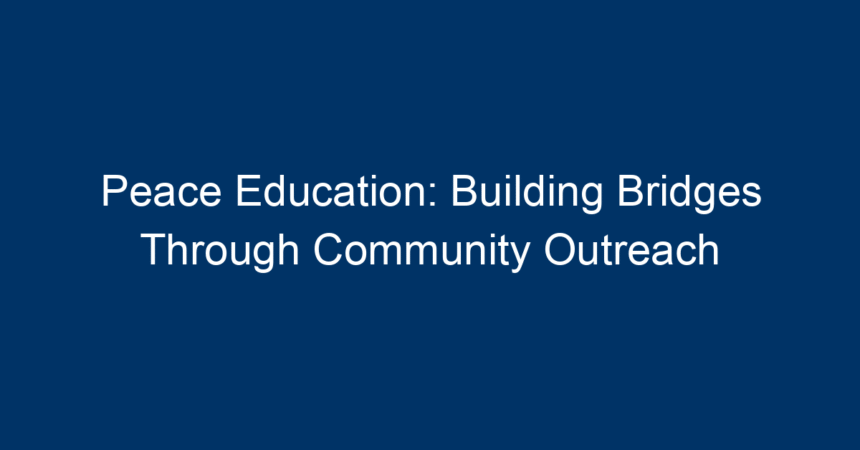Introduction
In a world increasingly characterized by conflict and division, the concept of peace education emerges as a vital tool to foster understanding, tolerance, and collaboration among diverse groups. Peace education goes beyond mere conflict resolution; it aims to instill the values of empathy and respect from a young age, creating a framework for peaceful coexistence. Community outreach plays a critical role in this educational endeavor, connecting individuals from various backgrounds and building bridges that nurture positive relationships. This article delves into how peace education, through community outreach initiatives, can create lasting impacts on society.
Understanding Peace Education
What is Peace Education?
Peace education encompasses a range of programs and practices designed to promote the values of peace, justice, and equality. It aims to equip individuals—especially children and youth—with the skills and knowledge necessary to engage in peaceful interactions and resolve conflicts constructively. Incorporating elements of social justice, human rights, and environmental sustainability, peace education seeks to create a holistic approach to fostering a more harmonious society.
The Importance of Peace Education in Today’s World
As societies grapple with issues such as violence, discrimination, and inequality, the importance of peace education cannot be overstated. By integrating peace education into school curriculums and community programs, we can foster a generation that prioritizes dialogue and understanding over hostility and division.
Key Principles of Peace Education
-
Empathy and Understanding: Encouraging individuals to understand diverse perspectives and experiences.
-
Conflict Resolution: Teaching skills to resolve disputes amicably, promoting a culture of dialogue.
-
Social Justice: Raising awareness about inequalities and equipping individuals with the tools to promote equity.
-
Critical Thinking: Instilling the ability to analyze conflicts and societal issues rationally and reasonably.
- Global Citizenship: Encouraging a sense of responsibility toward local and global communities.
The Role of Community Outreach in Peace Education
Building Bridges Through Local Engagement
Community outreach serves as the backbone of peace education, transforming theoretical knowledge into real-world application. Through outreach initiatives, organizations can engage with diverse populations, including schools, community centers, and religious institutions.
Creating Safe Spaces for Dialogue
Outreach programs often create safe spaces where individuals can openly express their thoughts and feelings. These environments foster trust and respect, enabling participants to explore their shared humanity, thereby bridging cultural, economic, and ideological divides.
Collaborative Workshops and Activities
Workshops focusing on conflict resolution, negotiation skills, and collaborative problem-solving can reinforce the principles of peace education. These interactive sessions can include:
-
Role-Playing Exercises: Participants act out scenarios to practice conflict resolution skills in a controlled environment.
-
Storytelling Circles: Sharing personal experiences promotes understanding and empathy.
- Art and Music: Creative expression can serve as powerful mediums to reflect on and address societal issues.
Community Advocacy and Awareness Campaigns
In addition to workshops, outreach initiatives can involve advocacy campaigns aimed at raising awareness about conflict-related issues within communities. Initiatives such as peace fairs, film screenings, and panel discussions can help disseminate information and inspire action.
Successful Community Outreach Models
Case Study: Peace Education in Schools
One successful model of community outreach integrating peace education is the PeaceBuilders program, which operates in schools across the globe. This program focuses on teaching students conflict resolution strategies while engaging parents and teachers in the process. The program has successfully reduced incidents of bullying and increased overall school morale.
Interfaith Dialogue Initiatives
Another inspiring example is interfaith dialogue initiatives that bring together individuals from diverse religious backgrounds to discuss common values and address misconceptions. These programs help foster understanding and respect among different faith communities, demonstrating how peace education can unite rather than divide.
Youth-led Initiatives
Empowering youth to take the lead in peace education initiatives has been particularly effective. Programs that train young leaders to facilitate workshops, participate in community service, and conduct outreach can create a ripple effect within their communities. The Youth Peace Network is a notable example, providing resources and training to young activists worldwide.
Challenges and Solutions in Implementing Peace Education
Overcoming Resistance
One of the significant challenges to implementing peace education through community outreach is overcoming resistance from individuals who may perceive such initiatives as threatening to their beliefs or values. Overcoming this requires:
-
Building Trust: Establishing long-term relationships with community leaders can help in addressing concerns and fostering collaboration.
- Inclusive Programming: Ensuring that programs reflect the community’s diversity can help individuals feel represented and more likely to engage.
Securing Funding and Resources
Sustainable outreach initiatives often face funding challenges. Solutions might include:
-
Partnerships with Local Organizations: Collaborating with businesses, educational institutions, and NGOs can provide necessary resources and amplify outreach efforts.
- Grant Applications: Seeking local, national, or international grants dedicated to educational initiatives can help secure long-term funding.
Measuring Impact
Assessing the effectiveness of peace education programs can also pose challenges. Implementing feedback mechanisms, such as surveys and community feedback sessions, can help organizations refine their programs and demonstrate impact.
Conclusion: Taking Action Toward a Peaceful Future
Peace education is not simply an academic concept; it’s a necessary movement toward building a peaceful society. By harnessing the power of community outreach, we can create opportunities for dialogue and understanding, ultimately leading to more harmonious interactions among diverse populations.
Actionable Steps for Communities
-
Develop Local Partnerships: Collaborate with schools, faith groups, and NGOs to create comprehensive outreach programs.
-
Conduct Workshops: Organize regular workshops that focus on conflict resolution, dialogue facilitation, and understanding cultural differences.
-
Promote Youth Engagement: Empower young leaders by providing them with the support and resources needed to initiate their own peace-building projects.
-
Evaluate and Adapt Programs: Regularly assess outreach initiatives to ensure they are meeting community needs and fostering the principles of peace education.
- Advocate for Inclusive Policies: Work within local governments to promote policies that prioritize peace education in schools and communities.
By adopting these approaches, communities can play a pivotal role in cultivating a culture of peace, ultimately leading to a more inclusive and understanding world. Remember, each step taken towards peace education can have profound ripple effects that echo throughout society.




